CBD FOR PETS
Dr. Joe Wakshlag
 You've probably heard about CBD, or Cannabidiol, a cannabis compound boasting significant medical benefits. Research on the safety and efficacy in pets is still being conducted, states Dr. Joe Wakshlag. He'll help us parse out all the claims and navigate the double-talk.
You've probably heard about CBD, or Cannabidiol, a cannabis compound boasting significant medical benefits. Research on the safety and efficacy in pets is still being conducted, states Dr. Joe Wakshlag. He'll help us parse out all the claims and navigate the double-talk.
These days, you don't have to go very far to find CBD. Dr. Joe Wakshlag, DVM and PhD, Associate Professor, Sections of Clinical Nutrition and Sports Medicine and Rehabilitation, Cornell University College of Veterinary Medicine explains just what CBD does and how it helps our pets.
First of all, CBD stands for cannabidiol; a compound found in marijuana plants that relieves pain and anxiety. CBD also has some anti-inflammatory properties, which can help our pets get relief.
While there are no known side effects, they have seen some mild increase in liver enzymes. One enzyme is called alkaline phosphatase, which is a pretty nondescript enzyme that goes up with a lot different medications potentially.
Is the price of CBD similar to other anti-inflammatories? Dr. Wakshlag says that that is the real conundrum. You can pay basically between a dollar for a dose or up to three or four dollars a dose, hypothetically. He thinks the dose is about two milligrams per kilogram of body weight based on their study.
Many companies are jumping on the bandwagon and making treats for pets containing CBD. Dr. Wakshlag explains that we really don't know which ones are good and which ones are bad. They do have some of the evidence from studies done at Cornell initially and then over at Colorado State. Some companies gave them oil, so they know what it is and it was fairly consistent. However, since companies making these treats are a dime a dozen, they have no idea what they really contain.
Dr. Wakshlag tells us that someone just looked at 14 products in a laboratory and came across very insignificant amounts of CBD to what he knows can be in a product, which is what he found in the products he uses, which is ElleVet Science' product.
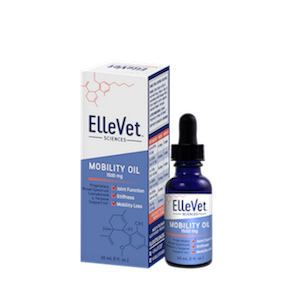 Is it safe to say that the normal person might not notice if one of these things is working on their pet, because our pet can't tell us if they are feeling much better? Does this make it easier for these companies to go after the pet market because people can't really prove whether it's working or not?
Is it safe to say that the normal person might not notice if one of these things is working on their pet, because our pet can't tell us if they are feeling much better? Does this make it easier for these companies to go after the pet market because people can't really prove whether it's working or not?
Dr. Wakshlag thinks there's enough evidence using various pain scores and various activity indices that have been validated for owner use. This is what they used in their study. It has been shown that dogs can jump on beds again and sometimes they will start playing with other dogs. Is that a pain response? Are they just feeling better overall? It's hard to really assess, but they've really kind of used what they call the validated scoring systems for pain and/or activity and it's shown improvements. So that's about as good as they've got.
According to Dr. Debbie, what they have done is taken it from a level of just someone just buying it on the Internet and saying, "I think my dog's better on it." They're trying to get away from that and have some kind of way to compare patient one, two or three down the road and say is this really something measurable we can report back to pet owners, rather than just say, "Oh yeah, try it, I bought it online and it works."
So what if you want to try this because you have an animal that might be in some pain? Is it too early really to start using this stuff? Do we need more research?
We certainly need more research, according to Dr. Wakshlag, particularly since it has indications for potentially seizures, anti-nausea, quality of life parameters, etc. Unfortunately, the DEA has folks running scared about using it. So until the DEA actually comes around and says we can start using it, it is not allowed. There are a whole bunch of logistical things that are going on between CBD being classified as a schedule five drug, which means anybody can use it anywhere, anytime. However, the DEA has put stipulations on where it can come from and whether the FDA's approved it. The farm bill is a whole different thing, which in essence supersedes anything that the DEA is talking about. We need more research for sure, but he thinks it's going to be a while before we see it.
Visit Website
Goat Momma
Leanne Lauricella, 'Peace, Love, Goats of Anarchy'
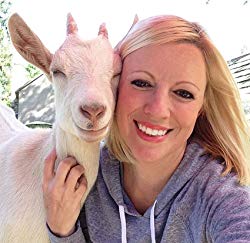 Leanne Lauricella gave up her NYC corporate job, traded in her Mercedes for a pickup truck, and decided to care for handicapped goats. She'll never look back! She says it was the best decision ever. She has taken-it-up a level by integrating her love for goats throughout social media. Leanne has even published many books.
Leanne Lauricella gave up her NYC corporate job, traded in her Mercedes for a pickup truck, and decided to care for handicapped goats. She'll never look back! She says it was the best decision ever. She has taken-it-up a level by integrating her love for goats throughout social media. Leanne has even published many books.
Leanne is the proud guardian of many goats, including "Polly," the goat that wears a duck costume. Polly's viral video has people up in arms asking why she's dressing her goat in a duck costume.
Years ago Leanne Lauricella was an Event Planner in New York City doing corporate events. After living in the city for some time and after getting married, Leanne decided that this isn't what life was supposed to be for her. She wanted something different and something more.
Leanne is originally from Houston, Texas, so she was in no way a 'farm girl' and didn't grow up near any farms. However, in New Jersey there are many beautiful farms. As Leanne started to drive by them and saw pastures of little goats, she felt she had to have some.
She ended up buying a couple of baby goats, Jax and Opie, and fell in love with them. Then two goats turned into five goats. She eventually told her husband that she couldn't do both the goats and work in the city, so she had to make a choice. She hated her life and decided that the city had to go and from now on it would be the goats. She then took a leap of faith and quit her job. This was frightening, as she had never 'not' had a job before.
Starting off, Leanne created an Instagram account and called it "Goats of Anarchy," because she wanted to share how silly and funny her goats were with her family and friends. On her very first day of unemployment, Instagram featured one of her photos on their home page and she received 30,000 hits. The photo was of Polly. Polly is a blind goat and she would wear a duck costume that would keep her calm, which went viral. Leanne took this as a sign that she was on the right track and that she was supposed to do something with animals. It has since grown from there and she now has about half a million followers.
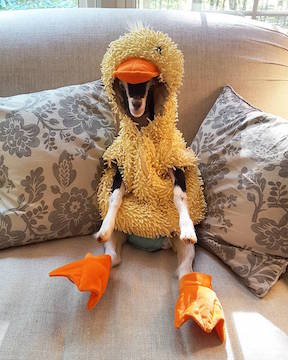 This has helped Leanne promote what she is doing. She has many now, including children's books. One of them is a book she wrote called, "Peace, Love, Goats of Anarchy. She also has calendars and all kinds of stuff. These all help fund what she does. She's a special needs goat rescue. She specializes in goats that have lost limbs, mostly due to frostbite. However, some are as the result of injuries so their limbs have been amputated and some of them are even birth defects. She gets some of these goats wheelchairs, as well as little carts to get around. She also works with Bionic Pets to fabricate prosthetic limbs for them. She tells us that she has many goats who are in some sort of a prosthetic or wheelchair cart. She calls them her "Robo Goats."
This has helped Leanne promote what she is doing. She has many now, including children's books. One of them is a book she wrote called, "Peace, Love, Goats of Anarchy. She also has calendars and all kinds of stuff. These all help fund what she does. She's a special needs goat rescue. She specializes in goats that have lost limbs, mostly due to frostbite. However, some are as the result of injuries so their limbs have been amputated and some of them are even birth defects. She gets some of these goats wheelchairs, as well as little carts to get around. She also works with Bionic Pets to fabricate prosthetic limbs for them. She tells us that she has many goats who are in some sort of a prosthetic or wheelchair cart. She calls them her "Robo Goats."
Leanne explains that her goats really are just so inspiring. While she has had a lot of sad heartbreaking times, she's also had a lot of really happy and proud moments just watching them overcome obstacles. The thing about these little goats is they never give up. They're the strongest little animals she has ever seen. They don't know that they are different. A lot of them are handicapped and have special needs, but they just go with it and they still live life to the fullest. She thinks that the way that they look at life can teach a lot of us to do the same.
Leanne said she didn't know anything about goats and learned by doing. It started when she got two goats and then three more. Next, the Instagram thing happened and someone who was following her sent her a message about two little twin goats with birth defects. So, she said, "Why not?" They turned out to be her first special needs goats. Next, someone else saw that she was successful in dealing with special needs goats and asked her if she would take another one that had frostbite. This just kept happening. Leanne had never had any intention of doing special needs goats. She also never intended on being a rescue. But after she kept taking in these special needs goats, she thought she would just go for it and set up an actual sanctuary. She says it all happened very naturally, very organically and she just learned along the way.
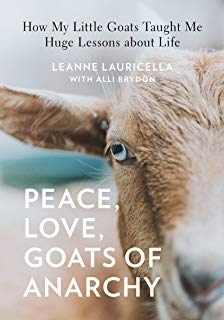 There are hundreds, if not thousands, of people who have given up their job to rescue animals. Most of them don't have social media and books to help them. It's a tough time for them. However, Leanne explains that she has a little bit of marketing background. She knew a little bit about how to build a social media following, which is very important obviously for support. She explains that social media is everything. Those are the people who you engage with and fall in love with your animals. They want to see your animals succeed and they want to see you succeed, so they support your mission.
There are hundreds, if not thousands, of people who have given up their job to rescue animals. Most of them don't have social media and books to help them. It's a tough time for them. However, Leanne explains that she has a little bit of marketing background. She knew a little bit about how to build a social media following, which is very important obviously for support. She explains that social media is everything. Those are the people who you engage with and fall in love with your animals. They want to see your animals succeed and they want to see you succeed, so they support your mission.
Leanne's first book was a photo book that told little stories about each of her goats at the time. Next she did a children's book series with four kid's books that tell cute little stories. One of these books was Polly in her duck costume including some little life lessons for kids. Then there was The Goats of Anarchy, which is more about how she got started and built her sanctuary.
While Leanne's farm is not open to the public, they do allow people to come and volunteer. They can sign up with her volunteer coordinator. She wants people to come out and be able to meet the goats. She tells us one of the things that people always say is that they can't believe that they're just like dogs. They have individual personalities. They want affection. They want attention. They want to be hugged and loved. Leanne says everyone should go meet a goat!
Visit Website
Pheromones In Puppy Training - Dr. Debbie
 So you just got a new puppy and you have all your training tools at the ready, the collar, leash and dog crate. But beyond that, do you have the one thing that can make your training tasks easier all around? Tap into your puppy's own sense of smell using canine pheromones and ease your new pup's training and transition into the home.
So you just got a new puppy and you have all your training tools at the ready, the collar, leash and dog crate. But beyond that, do you have the one thing that can make your training tasks easier all around? Tap into your puppy's own sense of smell using canine pheromones and ease your new pup's training and transition into the home.
Pheromones are scent signals emitted by all animal species, including humans. Various pheromones work under the radar to influence the perceptions and behaviors of others within a species.
Shortly after whelping, a pheromone is emitted from the bitch's sebaceous (oil) glands located between the mammary glands. The pheromone, dubbed the canine appeasing pheromone, reassures the puppies, calms them and facilitates nursing. The bitch stops emitting this pheromone as the pups mature, but all dogs retain the ability to "read" this pheromone. Not only do older dogs recognize this pheromone, but it continues to have a natural calming effect on canines of all ages.
In veterinary behavior cases, the dog appeasing pheromone is used for dogs with noise phobias, car travel anxiety, separation anxiety and other fearful situations. Various forms are available including pheromone collars, plug in diffusers and sprays. The canine appeasing pheromone doesn't sedate the dog; rather it decreases fear and excitability.
The dog appeasing pheromone is also helpful for newly adopted puppies. Those first few days to weeks in a new home are full of changes for the pup faced with novel environments far from the comfort of mother and siblings. The dog appeasing pheromone has been shown to ease the transition of the pup into new home and improve sociability and training during a pup's critical socialization period.
Pheromone Research
For skeptics that need to see the proof in the studies, veterinary behavior studies have examined the positive influence of the dog appeasing pheromone. When comparing treatment responses for dogs with separation anxiety, the use of the dog appeasing pheromone equaled the benefit of the anti-anxiety medication, amitriptyline.
One study looked at 66 puppies as they settled into new homes after adoption. Approximately half of the puppies wore a pheromone collar and half wore a placebo. The study found that puppies wearing a pheromone collar displayed significantly fewer nuisance behaviors like vocalizations or scratching within 3 days of adoption. Pups wearing the pheromone collar woke their owner's less during the night and displayed fewer signs of distress and vocalizations throughout the course of the study.
The researchers concluded that pheromone collars helped both the pup and family. Pups were less stressed and adapted easier. By decreasing the pup's stress and fearful behaviors, the pet owners found a more enjoyable bonding experience with the new pup and faced less frustration through the training process.
 In another study, puppies 8 to 15 weeks were enrolled in an eight-week long puppy socialization and training class. Half wore a pheromone collar and the other half wore a placebo collar. The pups wearing the pheromone collar were calmer in the face of novel experiences and displayed less fear, anxiety, and aggression. In the end, the pups with the pheromone collar not only were less nervous, but had fewer behavioral problems and learned better. And a long-term effect on sociability was recognized in dogs up to one year after the class and study was completed.
In another study, puppies 8 to 15 weeks were enrolled in an eight-week long puppy socialization and training class. Half wore a pheromone collar and the other half wore a placebo collar. The pups wearing the pheromone collar were calmer in the face of novel experiences and displayed less fear, anxiety, and aggression. In the end, the pups with the pheromone collar not only were less nervous, but had fewer behavioral problems and learned better. And a long-term effect on sociability was recognized in dogs up to one year after the class and study was completed.
Pheromones and My Pup
As a previous owner of a nine-week old Bouvier puppy named Nikki, I used both the pheromone collar and diffuser upon welcoming my new pup home. One day before bringing Nikki home, I placed a pheromone diffuser close to the puppy crate, where it would have maximum benefit during her first nights in the kennel away from mother and siblings. Immediately upon leaving the breeder's home, Nikki was fitted with a pheromone collar to serve as a source of reassuring pheromones that went everywhere she did. The pheromone collar became a tool in Nikki's socialization. It was on her when she met new people or animals, when she explored new environments and during puppy kindergarten class.
Did pheromones help in my pup's transition and training? The four hour drive home from the breeders was a dream, no crying or whining the entire trip. After returning home, Nikki never soiled in her kennel during the day or night. I'll admit I had my share of interrupted sleep in the first two weeks, but most of Nikki's night time wakes were for genuine elimination needs. Overall, her transition into the home was smooth and lacked the wailing, inconsolable cries of a stressed pup.
The canine appeasing pheromone isn't a magic bullet though. Nothing matches a quality pup obtained from a reputable breeder who focuses on health, genetics and early socialization. Likewise, pheromones do not replace the hard work and consistent training efforts that any new pet owner must provide. However, by adding the the canine appeasing pheromone to your new puppy training, you can help your pup become the best he or she possibly can.
Featured veterinarian known as "Dr. Debbie" on national pet radio program, Animal Radio. Ebook author of "Yorkshire Terriers: How to Be Your Dog's Best Friend"; "Pugs: How to Be Your Dog's Best Friend"; "Mini Schnauzers: How to Be Your Dog's Best Friend"; and "Shih Tzu: How to Be Your Dog's Best Friend." Dr. Debbie's books.
Visit Website
 The Dogfather's Grooming Tip with Joey Villani
The Dogfather's Grooming Tip with Joey Villani
'Skunked'
"The worst thing you can do when your dog has been sprayed by a skunk is to use tomato juice." That's according to Animal Radio's very own "Dogfather" Joey Villani. Besides not being effective, it's also pretty messy. But fear not! Joey has the perfect recipe of household products to fix this smelly problem.
Right now it seems to be Skunk Season, as they are out in full force. So it's no surprise that a lot of dogs are being sprayed.
Joey tells us that instead of calling him right away, people usually try to do their own home remedies. I'm sure you've heard the old wives tale of using tomato juice as acids from the tomatoes are supposed to neutralize the odor. However, it doesn't work and it makes a mess. Just think if you have a big dog that doesn't want to get a tomato juice bath. You can't control them and they run through the house covered in tomato juice, spreading it everywhere. So not only do you have a dog and a house that smells like skunk, but you have to then clean up stains from the tomato juice.
Joey says that he always has different remedies and searches to find the best one. He explains that when a skunk sprays, it's mainly scented oil. So what happens when you go right to just putting water on the pet trying to rinse it off? It actually sets in the oils and the scent will remain a lot longer. Water makes it worse.
What you want to do is to break it down first. What Joey has found over the past few months that actually works better is, if you're doing it at home, fill your tub up with tepid water. This is water that's comfortable for you to take a nice warm bath. Then you want to add about a half of cup of your favorite pet shampoo and mix it in the water. The put you dog in there and have them sit down. Just make sure that there is soapy water in the tub before your dog gets in. The soap will help break down the oils. If not, plain water will set the smell in, making it almost impossible to remove. Next, you're going to use a cup to wash the solution over your pet or you cane even use a sponge to soak your pet with the soapy water.
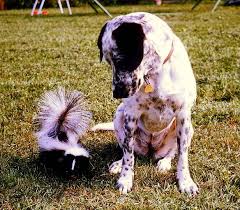 But before you do this, you need to make up another solution. Take a half a quart of hydrogen peroxide, an eighth cup of baking soda and a teaspoon of dishwashing soap. You can use any kind of dishwashing soap. Then mix it all together on your wet soapy dog that is already in the tub. You want to apply this mixture all over your dog, just don't get it in their eyes. Work it in really good to where it gets real sudsy. Then let the solution sit on your dog for about five minutes and rinse it off. If there are still smelly areas on your pet, go ahead and just repeat the process all over again.
But before you do this, you need to make up another solution. Take a half a quart of hydrogen peroxide, an eighth cup of baking soda and a teaspoon of dishwashing soap. You can use any kind of dishwashing soap. Then mix it all together on your wet soapy dog that is already in the tub. You want to apply this mixture all over your dog, just don't get it in their eyes. Work it in really good to where it gets real sudsy. Then let the solution sit on your dog for about five minutes and rinse it off. If there are still smelly areas on your pet, go ahead and just repeat the process all over again.
If you do this right, you're going to remove most of the smell. Joey states that he has never seen anything take away 100 -percent of the smell, but you can reduce it up to 75 to 90-percent, which makes it tolerable.
Unfortunately a big problem regarding encounters of dogs and skunks is that a dog usually approaches a skink face first, so they get shot right in the mouth. There's not too much you can do at that point. Do not use the solution in their mouth. Unfortunately they will have bad breath for a while.
Joey tells us that skunks are nocturnal, so groomers usually get the dog the next morning when people have tried to deal with it at home and have made a mess of things. So again, if you are going to do it at home, soak your dog in soapy water first.
Animal Radio News - Lori Brooks
 Selfies Include Pets
Selfies Include Pets
Pet owners in the UK were asked if they included their cat or dog in selfies posted to social media, as part of research into our relationships with our pets. Dr. Lori Kogan, of Colorado State University, said the US study suggested 50-percent of pet owners had their pet as their feature photo on their devices and that behavior offers insights into the close bonds between people and cats and dogs in America. The scientists then looked to see if this trend was similar in the UK to better understanding the people/pet bond. There is estimated to be more than nine million dogs and eight million cats that are pets in the UK. In the US, there are many more pets with an estimated 70 million dogs and 74 million pet cats.
Having Trouble Sealing Pet Food Bags?
There is a huge gigantic clip for pet food bags. It's not going to keep the bag fresh forever, but will at least keep a stray cat on the counter from digging in it. It re-seals large bags of pet food with a carry handle. It also helps you control when you pour out the content if you clip it on an angle to create a pour spout. It's called the The Handy Camel Clip and might be a good stocking stuffer.
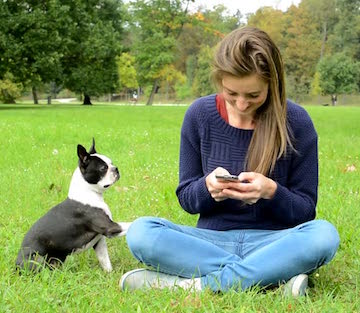 Put Your Phone Down and Stop Ignoring Your Pet
Put Your Phone Down and Stop Ignoring Your Pet
Data from USC's Annenberg Center showed that on average Americans spent nearly 24 hours per week online. Sadly, according to some research, this was not a good thing for our pets. A study came out and started conversations around how pets may get anxious and even depressed when we spend too much time on our smartphones. Actually, the study was mainly about the positive effects pets have on people suffering from mental illness, but somehow the conversation shifted to how when we spend time on our phones and devices instead of engaging with our pets, we're essentially ignoring them, which can make them feel lonely and isolated. Several animal professionals came out saying that this was actually a real problem. One veterinary surgeon said, "To understand what's going on, we have to look at the basic principles of how a dog interacts physically and emotionally with a human. A dog is a social creature, a pack animal. And to the dog, you are the bona fide leader of the pack. … But if you're perpetually attached to your phone, that vital bond breaks down." And he added, those hours we spend ignoring our pets add up and can lead to behavioral issues.
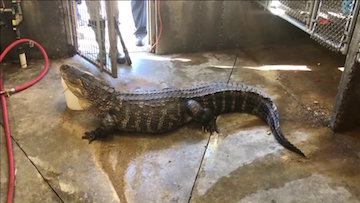 Chicken-Nugget Eating Alligator Evicted From Home
Chicken-Nugget Eating Alligator Evicted From Home
Authorities in Missouri, discovered an unexpected occupant when they went to evict a man from his grandmother's home. (The grandmother was in a nursing home.) Inside the home, police found the man they were looking to evict along with three snakes, a rabbit and a 7-foot, 200-lb. alligator all inside the home. Animal Control was called in to remove the gator. They probably don't get many alligator calls in Missouri. The grandson said the gator was only 15-inches long four years ago and grew bigger over time on a steady diet of chicken nuggets, steak, deer and fish. Believe it or not, officers said the alligator was like a dog that didn't know he was really an alligator. The grandson was interviewed later and added the alligator is afraid of the dark and thunderstorms. The alligator, who allegedly loves sitting on laps, was moved to a wildlife rescue center, which is home to several other illegal pet alligators that got too big for their owners.
 Listen to the entire Podcast of this show (#1197)
Listen to the entire Podcast of this show (#1197)





